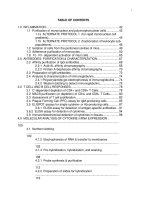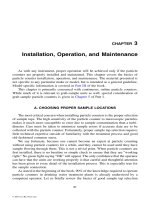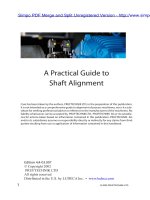A Practical Guide to Shaft Alignment phần 3 pot
Bạn đang xem bản rút gọn của tài liệu. Xem và tải ngay bản đầy đủ của tài liệu tại đây (3.11 MB, 10 trang )
21
Troubleshooting
Coupling strain and shaft deection
New readings do not agree with moves just made?
When performing an alignment whether using dial indicators or laser
optical systems, sometimes the readings following an alignment
adjustment do not agree with the corrections made. One possibility is
that coupling strain is deecting the shaft, the machine mounts or the
foundation. This has frequently been noticed particularly on pump sets
which have a front “steady” mount as shown in the following sketch.
In this application the exible coupling element is radially quite rigid
and can inuence the alignment measurement. In this situation we
advise splitting the coupling element to free the measured alignment
from such external forces.
If not accomodated the net effect of inuences such as noted above is
that the new alignment is not only wrong but quite often has been made
in the opposite direction to the required alignment correction.
In extreme cases coupling strain imposed by the newly aligned machines
can bend shafts during operation. In most cases this bending will be
minimal but sufcient to affect the measured axes of shaft rotation.
The following sketches illustrate the potential problem.
© 2002 PRUFTECHNIK LTD.
22
Troubleshooting
This is the alignment condition with shafts uncoupled
This is the measured alignment with the shafts coupled.
Projected centerlines of rotation are shown
The moves are made as measured. There is less strain on the
coupling now and the shafts can be properly aligned at the next
attempt.
© 2002 PRUFTECHNIK LTD.
23
Causes of machine breakdown
Couplings can take misalignment?
An often quoted comment is “ why bother to align the machine when
it is tted with a exible coupling designed to take misalignment?”
Experience and coupling manufacturers’ maximum misalignment
recommendations would suggest otherwise. Anecdotal evidence
suggests that as much as 50% of machine breakdowns can be directly
attributed to incorrect shaft alignment.
It is true that exible couplings are designed to take misalignment,
typically up to 400 mils or more radial offset of the shafts. But the load
imposed on shafts, and thus the bearings and seals increase dramatically
due to the reaction forces created within the coupling when misaligned.
© 2002 PRUFTECHNIK LTD.
24
Causes of machine breakdown
Anti-friction Bearings
Bearings are precision manufactured components designed to operate
with clean lubrication and constant but restricted operating temperatures.
Components manufactured within 0.2 mils accuracy are:
Not able to withstand operating for long periods at elevated
temperatures caused by misalignment.
Not able to withstand contamination caused by mechanical seal
failure which has allowed ingress of dirt, grit, metallic elements
or other objects.
Not manufactured to operate for long periods with misalignment
imposing axial shock loads on the carefully machined and honed
components.
In addition to the damage imposed on the bearings through the
misalignment itself, when mechanical seals fail, bearings have to be
removed from the shaft assembly, sometimes re-tted or in most cases
replaced. Removal and re-tting in itself can cause bearing damage.
Most pump manufacturers and repairers recommend that when repairing
damaged pumps, bearings should always be replaced irrespective of
apparent condition, since it is easy to miss minor damage to the bearing
that will progessively worsen after re-tting.
Mechanical Seals
Seal wear increases due to shaft loading when shafts are misaligned.
Pump seals are a high cost item often costing up to a third of the
total pump cost. Poor installation and excessive shaft misalignment
will substantially reduce seal life. Manufacturers have addressed the
problem of poor installation practice by the introduction of cartridge
type seals which can be installed with little or no site assembly. Seals
however have precision ground and honed components with nished
accuracy of 2 microns (0.08 mils) they do not tolerate operation in
a poorly aligned condition, face rubbing, elevated temperatures and
ingress of contaminants quickly damage expensive components. Seal
failure is often catastrophic, giving little or no pre warning, the resultant
plant downtime, seal replacement costs, pump repair costs and bearing
replacements makes seal failure due to misalignment an expensive and
unnecessary problem.
© 2002 PRUFTECHNIK LTD.
25
Causes of machine breakdown
The benets that accrue from adopting good shaft alignment practice
begin with improved machine operating life thus ensuring plant
availability when production requires it. Accurately aligned machinery
will achieve the following results.
Improve plant operating life and reliability
Reduce costs of consumed spare parts such as seals and bearings
Reduce maintenance labor costs
Improve production plant availability
Reduce production loss caused by plant failure
Reduce the need for standby plant
Improve plant operating safety
Reduce costs of power consumption on the plant
“Push” plant operation limits in times of production need
Obtain better plant insurance rates through better operating prac-
tice and results
Symptoms of misalignment
It is not always easy to detect misalignment on machinery that is running.
The radial forces that are transmitted from shaft to shaft are difcult to
measure externally. Using vibration analysis or infrared thermography it
is possible to identify primary symptoms of misalignment such as high
vibration readings in radial and axial directions or abnormal temperature
gradients in machine casings, but without such instrumentation it is also
possible to identify secondary machine problems which can indicate
inaccurate shaft alignment.
Machine vibration
Machine vibration increases with misalignment. High vibration leads
to fatigue of machine components and consequently to premature
machine failure.
The accumulated benets of shaft alignment
© 2002 PRUFTECHNIK LTD.
26
Causes of machine breakdown
Loose or broken foundation bolts.
Loose shim packs or dowel pins.
Excessive oil leakage at bearing seals.
Loose or broken coupling bolts.
Some exible coupling designs run hot when misaligned.
If the coupling has elastomeric elements look for rubber
powder inside the coupling shroud.
Similar pieces of equipment are vibrating less or have longer
operating life.
Unusual high rate of coupling failures or wear.
Excessive amount of grease or oil inside coupling guards.
Shafts are breaking or cracking at or close to the inboard
bearings or coupling hubs.
Good shaft alignment practice should be a key strategy in the
maintenance of rotating machines. A machine properly aligned will
be a reliable asset to the plant, it will be there when it is needed and
will require less scheduled (and unscheduled) maintenance. In a later
section we will review some specic case studies that will show how
shaft alignment will deliver substantial cost benets to operating plants.
The next section of this handbook however will review the various
methods of shaft alignment that can be used to deliver good installed
machinery alignment.
© 2002 PRUFTECHNIK LTD.
27
Alignment methods and practices
There are a number of different methods whereby acceptable rotating
machine alignment can be achieved. These range from an inexpensive
straight edge to the more sophisticated and inevitably more expensive
laser systems. We can condense these methods into three basic
categories,
Eyesight – straightedge and feeler gauges
Dial indicators – mechanical displacement gauges
Laser optic alignment systems
Within each category there are a number of variations and options, it is
not the intention here to evaluate all of these options, instead we will
concentrate on the most widely used methods in each category.
Preparation is important
The rst preparatory step toward successful alignment is to ensure that
the machine to be aligned may be moved as required: this includes
vertical mobility upwards (using proper lifting equipment, of course)
and downwards, should the machine require lowering, as is frequently
the case. This can be achieved by inserting 2 to 4 mm (0.08” - 0.16”)
of shims beneath the feet of both machines on initial installation (we
recommend shimming both machines initially so that changes in the
foundation condition may later be compensated, if need be).
Horizontal positioning of machines is best performed using jack bolts
or a simple ‘machine puller’ tool or hydraulic equipment, all of which
allow ne control of movement in a slow, gentle and continuous
manner. Methods such as hammers not only make exact positioning
more difcult but can damage machines (by causing chatter marks on
bearings), but the vibration could displace the alignment system during
the MOVE function and therefore lead to less accurate monitoring of
correction positioning.
© 2002 PRUFTECHNIK LTD.
28
Alignment methods and practices
The installation of machinery such as a pump, gearbox or compressor
etc. require some general rules to be followed.
The driven unit is normally installed rst, and the prime mover or
motor is then aligned to the shaft of the driven unit.
If the driven unit is driven through a gearbox, then the gearbox
should be aligned to the driven unit and the driver aligned to the
gear box.
Basic checks should be carried out to determine the accuracy
of the machine couplings, i.e. check for “run-out” (concentricity
and squareness to the shaft centerlines) of coupling halves using
a
dial indicator, if possible (out of “true” coupling halves can cause
out of balance problems!).
Preparation of the machinery baseplate and machine mounting
surfaces, feet, pedestals etc. is of paramount importance!
Successful alignment cannot be easily achieved otherwise!
Clean, dress up and le any burrs from mounting faces and
anchor bolt holes etc.
Have quality precut shims available to align precisely and
effectively.
Before assembling the shaft alignment system/ instrumentation
to the machines, take a few minutes to look at the coupling/shaft
alignment. Remember, your eyes are your rst measuring system!
Check that the pump/motor etc. is sitting square to the base plate.
(Soft foot check) and correct as required - see following pages.
Keep shims to a minimum i.e. no more than 3 shims maximum if
possible under machinery feet/mounts.
Correct alignment as required to ensure that, when the machinery
is running, the machinery shafts are centered in their bearings and
are aligned to manufacturers’ tolerances.
Machine installation guidelines
© 2002 PRUFTECHNIK LTD.
29
Alignment methods and practices
Always check manufacturers alignment gures prior to
commencing work! - temperature growth may require specic
“cold” alignment offsets.
Ensure that any pipework attached to machines is correctly
supported but free to move with thermal expansion.
Measurement and correction of soft foot
An essential component of any successful alignment procedure is the
determination and correction of soft foot. Just as a wobbly chair or table
is an annoyance, a wobbly machine mount causes alignment frustration.
The machine stands differently each time an alignment is attempted,
and each set of readings indicate that the machine is still misaligned.
Additionally when the machine is bolted down, strain is placed upon
the machine casing and bearing housings. Essentially, there are three
types of soft foot, two of which are illustrated in the sketch below.
Parallel soft foot indicates that the baseplate and machine foot are
parallel to each other allowing correction by simply adding shims of
the correct thickness. Angular soft foot is caused by the machine feet
forming an angle between each other. This situation is more complex
to diagnose and to correct. One solution is to use tapered shims to ll
the angular space between the baseplate and the foot; a more drastic
but long term solution is to remove the machine and grind the machine
feet at (or correct the angle of the baseplate)
© 2002 PRUFTECHNIK LTD.
30
Soft foot measurement
Using a variety of techniques, soft foot can be determined prior to
alignment commencing.
Using a laser alignment system loosen one machine foot at a time
the alignment system calculates the amount of foot lift at each foot.
Retighten the machine foot before proceeding to the next foot.
Having determined the amount of soft foot present as indicated below
it is possible to make adjustments to the machine according to the soft
foot condition diagnosed.
This example shows classic soft foot problems with a rock across feet
B and D. It is tempting to shim both feet to eliminate the rock but this
would be a mistake. The best solution would be to shim only the foot
with the highest value and recheck all four feet.
Many additional soft foot problems may be found including bent feet,
strain imposed by pipe work or “squishy foot cause by too many shims
under the machine feet. Some examples are shown in the following
sketches.
Alignment methods and practices
2
22
18
0
© 2002 PRUFTECHNIK LTD.









